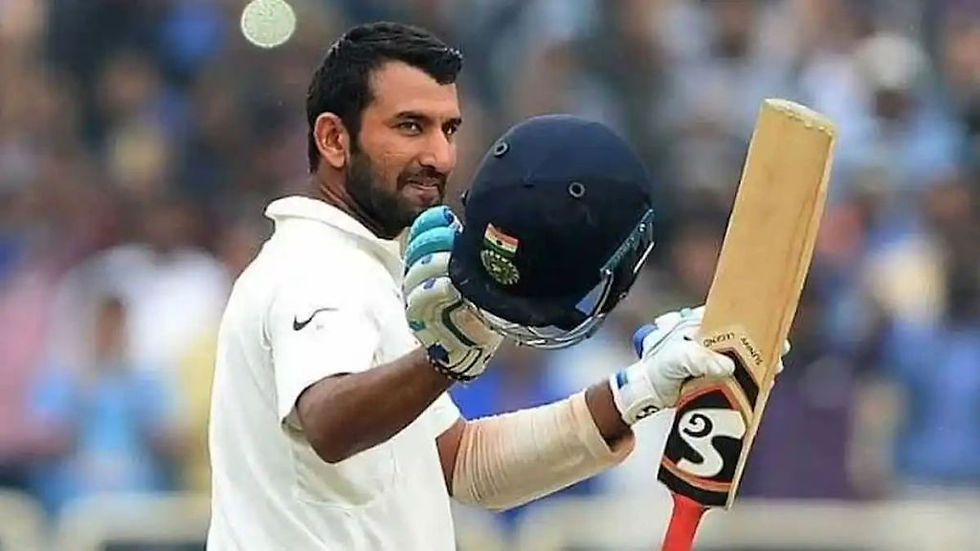A Fond Farewell to Cheteshwar Pujara
- Waleed Hussain

- Aug 24
- 3 min read

In the fast-paced circus that is modern cricket, where sixes rain like confetti and strike rates are worshipped like golden calves, Cheteshwar Pujara was the serene monk in the corner, methodically building his innings like a Lego fortress—one brick at a time. Now, as of this week in 2025, with his retirement announcement still fresh, it’s time to reflect on a career that embodied resilience, even if it occasionally tested our patience. Pujara, the man who made “grinding it out” an art form, deserves our respect for anchoring India’s Test triumphs abroad. But let’s be honest—with a dash of humor—he also had moments where his bat seemed stuck in molasses, crumbling under the weight of expectations (and perhaps a few too many dot balls).
Pujara’s Test cricket journey, spanning 103 matches, is a testament to his unshakeable grit. Debuting in 2010 against Australia, he quickly established himself as the heir to Rahul Dravid’s “Wall” legacy. With 7,195 runs at an average of 43.60, including 19 centuries and 35 half-centuries, his numbers speak volumes. His highest score of 206* against England in 2012 was a masterclass in controlled aggression—or should I say, controlled restraint? He became one of the fastest to reach 1,000 Test runs, doing so in just 11 matches and 18 innings, earning the ICC Emerging Cricketer of the Year award in 2013. But it’s his overseas exploits that truly shine. In Australia’s 2018-19 series, Pujara scored a mammoth 521 runs across four Tests, facing 1,258 balls—the most by any visiting batsman in a four-Test series Down Under. His three centuries there were pivotal in India’s historic 2-1 victory, the first time an Asian team conquered the Aussies on their turf. Fast-forward to 2020-21, and despite injuries ravaging the squad, Pujara’s 271 runs, including a gritty 56 in the Brisbane fortress-breaker, helped seal another 2-1 win. He batted for an average of 124 minutes per innings, the third-longest among modern Indian batters, often wearing down bowlers like a persistent telemarketer. Respect where it’s due: without Pujara’s marathon efforts, like his 525-ball 202 against Australia in Ranchi 2017, India’s middle order might have collapsed faster than a house of cards in a gale.
Yet, for all his accomplishments, Pujara’s career wasn’t without its comedic tragedies—failures that, in hindsight, add a human touch to his stoic persona. His strike rate of around 44 often felt like watching paint dry on a humid day; snails could lap him on the pitch. Critics, including Ricky Ponting, lambasted innings like his laborious 50 in the 2021 Sydney Test, calling it one of the worst in recent memory. It built pressure on teammates, turning potential chases into nail-biters. And oh, the crumbling under pressure! Pujara had a knack for getting set—beautifully, agonizingly—only to fall to a “jaffa” just when the team needed acceleration. Remember the 2023 World Test Championship final against Australia? His twin failures (14 and 27) symbolized a broader batting collapse, leading to his scapegoating and axing from the West Indies tour. Sunil Gavaskar defended him fiercely, arguing he was unfairly blamed for others’ flops, but the truth stings: Pujara’s inability to adapt to quicker tempos or short-ball barrages haunted him. In England, where bounce is king, he averaged a modest 29 across series, often poking tentatively like a kid testing hot soup. Domestically, his IPL snubs—no bids in 2015 auctions—highlighted his mismatch with white-ball cricket; he played just 30 IPL games, scoring at a pedestrian 20 average. Failures like these, as Pujara himself admitted in interviews, can “haunt you,” leading him to tweak his stance for Australia tours. Humorously, it’s as if the cricket gods gifted him infinite patience but forgot the turbo button. Even his wife, in her recent book, credits herself for dragging him through slumps, proving that behind every great wall is a greater support system.
In my opinion, Pujara’s story is one of specialization in an era demanding versatility. He wasn’t flashy like Kohli or explosive like Pant, but his “Chesistance”—that cult-favorite term blending Che Guevara and resistance—symbolized old-school Test cricket. Dropped repeatedly post-2023 for younger guns, his exclusion felt like benching a reliable old Volvo for a flashy Ferrari that might crash. Yet, it’s respectful to acknowledge the game’s evolution; his slow play sometimes amplified team pressures, turning draws into losses. Still, no one in the current lineup replicates his anchor role, as a former teammate lamented during India’s recent New Zealand drubbing.
(The writer is a senior journalist based in Mumbai.)





Comments